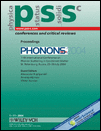Analogies and differences between the crystalline and the disordered state
Abstract
We report on a general feature of liquid and amorphous systems (metals, ionic systems, semiconductors), namely the spherical periodicity of nearest-neighbour shell distances and its influence on several properties. The electronic states as well as the dynamic excitations are influenced by two effects: spherical periodicity creates pseudogaps in their density of states at high energies, and its limited total mass causes low-energy effects. The former are mainly responsible for the stability of the phase and for absolute values of electronic transport properties, the latter for their temperature dependencies. Under particular conditions there is a spherical-periodic resonance between the electronic states, the static structure, as well as its dynamic excitations, which may be described as a new quasiparticle, the so called spheron. Besides its influence on electronic transport properties spherons may also affect dielectric glasses. (© 2004 WILEY-VCH Verlag GmbH & Co. KGaA, Weinheim)




